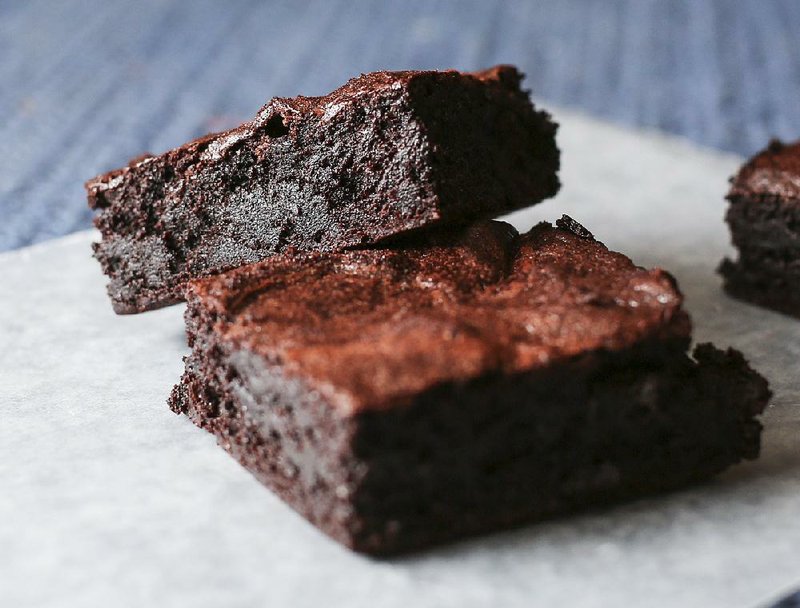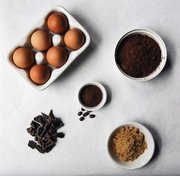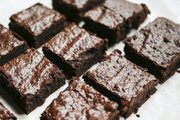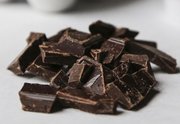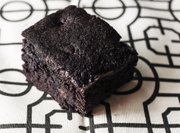What makes a better brownie? Melted chocolate or cocoa powder or both?
What's the ideal texture? Cakey or fudgy?
Why are some brownies -- often those from a mix -- so delectably chewy?
Why do some brownies have matte brown tops while others have a shiny, crinkly crust?
Is there such a thing as a good gluten-free brownie?
These are the questions we set out to answer in a project we called The Brownie Experiment.
Over the course of several months we researched, baked and ate brownies. Lots and lots of brownies.
What did we learn?
Brownies as we know them are an American creation, though exactly when and where they were created is debatable.
Sweets called brownies date to the late 19th century, but recipes for brownies in the 1890s did not include chocolate. Those recipes made what we would call a blondie today.
One story is that a Bangor, Maine, housewife created brownies by slicing and serving a failed (fallen) chocolate cake.
Other food historians credit Fannie Merritt Farmer, as the first recipe for brownies that includes chocolate appeared in Farmer's 1906 edition of The Boston Cooking School Cook Book. The recipe is almost identical to Farmer's recipe for chocolate cookies, except the flour is greatly reduced. But the 1906 book wasn't the first time Farmer used the brownie name. There was also a brownie recipe in the 1896 edition of The Boston Cooking School Cook Book, but it makes what we would call a blondie.
Other food historians believe the brownie is an American adaptation of the Scottish cocoa scone.
Regardless of their origin, brownies -- cousin to fudge, cookies and chocolate cake -- are arguably the best of all three worlds.
How do brownies get that shiny crinkly top?
Theories abound, but only one held for all of our tests.
According to The Science of Good Cooking, using all white sugar will create a glossy crinkly top.
This simply isn't the case.
In fact, our glossiest crinkly-topped brownies included granulated white sugar and brown sugar.
The likeliest explanation comes from food scientist Shirley O. Corriher in her book BakeWise: The layer is actually a meringue crust that is the result of thoroughly (or some might argue, excessively) beating the eggs with the sugar before adding the flour.
This makes sense if you consider that the recipe for those glossy, crinkly brownies calls for beating the eggs and sugar in a stand mixer for about 8 minutes before adding the chocolate and flour.
And what about texture, what makes a brownie cakey, chewy or fudgy?
Fudgy vs. cakey is easy. Fudgy brownies contain less flour than cakey brownies. Using all cocoa will also produce a soft, fudgelike brownie. For cakey brownies, in addition to the flour, adding a bit of leavening such as baking powder will give brownies some added lift. For a fudgy flavor, add some brown sugar. Brown sugar's added molasses not only adds moisture, but flavor notes as well.
But what about chew? How does one create that delectable chewy texture? Bread bakers know that protein and gluten development are what give a loaf good chew. But brownies don't contain that much flour and you certainly wouldn't want to knead them.
According to America's Test Kitchen the answer lies in the fat. Using a combination of butter and vegetable oil produces a chewier texture than
butter alone. American butter, on average, is about 80 percent fat -- 51 percent saturated fat, 21 percent monounsaturated fat, 3 percent polyunsaturated fat and 3 percent trans fat. Canola oil, on the other hand, is 7 percent saturated fat, 63 percent monounsaturated fat and 28 percent polyunsaturated fat. According to America's Test Kitchen it is the higher ratio of unsaturated fat that gives many brownie mixes their chewy texture.
Regardless of the type of brownie, for the best tasting brownies, use the best-quality chocolate and cocoa you can afford. And make sure your butter is fresh. (Butter that's been in the fridge for a long time can absorb off flavors.)
If you prefer your brownies with nuts, feel free to add up to 1 cup chopped pecans or walnuts to any of the recipes below.
This is by far our favorite brownie recipe. It has a deep, rich chocolate flavor; fudgy texture; and a delightfully crinkly crust.
Dark Fudgy Brownies
12 ounces (3 sticks) butter, plus more for coating pan
3 1/2 ounces unsweetened chocolate, coarsely chopped
2 1/2 ounces semi-sweet chocolate chips
2 1/4 cups granulated sugar
1/4 cup packed dark brown sugar
1 1/2 teaspoons kosher salt
6 eggs, chilled
1 tablespoon vanilla extract
1 teaspoon espresso powder
1 cup all-purpose flour
1 heaping cup Dutch-process unsweetened cocoa powder OR a blend of natural and Dutch-process cocoas
Heat oven to 350 degrees. Line a 9-by-13-inch baking pan with parchment paper or two sheets of aluminum foil, crisscrossing foil to create a sling. Brush foil or parchment with a little melted butter.
In a saucepan, melt the butter over medium heat. Cook, stirring with a heat-safe spatula, until butter is pale yellow. The butter will hiss and sputter. Continue cooking, stirring occasionally, until butter is silent, being careful to not to let the butter burn. Brown bits are OK. Remove from heat and stir in chocolates, stirring until smooth.
In the bowl of a stand mixer fitted with the whisk attachment (can use a hand-held electric mixer), combine the sugars, salt, eggs, vanilla and espresso. Beat on medium-high speed until thick and fluffy, about 8 minutes with a stand mixer (longer if using a hand mixer).
Meanwhile, sift together the flour and cocoa powder.
Reduce mixer to low and add the melted butter-chocolate mixture and mix just until incorporated. Then, using a rubber spatula, fold in the flour-cocoa mixture.
Pour into the prepared pan. Shake or tap pan gently on counter top to level batter. Bake 25 minutes or until internal temperature reaches 205 degrees. Cool completely in pan.
Brownies will keep, well-wrapped, for up to 1 week.
Recipe inspired by a recipe in BraveTart: Iconic American Desserts by Stella Parks (W.W. Norton, to be released Aug. 15)
Conventional wisdom holds that a combination of chocolate and cocoa will produce the best brownie. But if you love soft, fudgelike brownies this recipe adapted from Alice Medrich's book Bittersweet proves you can make a phenomenal brownie with cocoa only.
All-Cocoa Brownies
10 tablespoons butter
1 1/4 cups granulated sugar
3/4 cup PLUS 2 tablespoons unsweetened cocoa powder (natural, Dutch-process or a blend)
1/4 teaspoon kosher salt
1 teaspoon vanilla extract
1/2 teaspoon espresso powder, optional
2 eggs, chilled
1/2 cup all-purpose flour
Heat oven to 325 degrees. Line the bottom of an 8-inch square baking pan with parchment paper or foil, leaving an overhang on two opposite sides.
In a double boiler, or a large glass, ceramic or metal mixing bowl set over a pot of barely simmering water, combine the butter, sugar, cocoa and salt. Stirring occasionally, heat until butter melts and mixture is smooth (it will be grainy).
Remove bowl from heat. Whisk in the vanilla and espresso powder. Add the eggs one at a time, whisking vigorously after each addition. (For shiny, crackly tops use an electric mixer). Stir in the flour and mix thoroughly to combine. Spread evenly in the prepared pan.
Bake 25 to 35 minutes, until just set in the center. Cool completely in pan on a wire rack. Use overhanging paper or foil to lift brownies from pan to a cutting board. Cut into squares.
For cakelike brownie lovers, it doesn't get much better than this recipe from King Arthur flour. These brownies are somehow ethereal, yet fudgy at the same time. A glass of cold milk or a mug of steaming hot coffee are the ideal accompaniments to these rich, black-as-night brownies.
Cakey Brownies
1 cup butter, melted
2 1/4 cups granulated sugar
1 1/4 cups unsweetened Dutch-process cocoa powder or a blend of Dutch-process and natural
1 teaspoon salt (use less if using salted butter)
1 teaspoon baking powder
1 tablespoon vanilla extract
5 eggs
1/2 cup water
1 1/2 cups all-purpose flour
1 cup chocolate chips
Heat oven to 350 degrees. Line a 9-by-13-inch pan with parchment or foil. Lightly grease parchment or foil.
In a large mixing bowl, combine the melted butter and sugar, stirring until smooth. Stir in the cocoa, salt, baking powder and vanilla. Beat in eggs, one at a time. Scrape the bowl, then add the water, stirring until smooth. Stir in the flour, followed by the chocolate chips, stirring until thoroughly combined.
Spoon the batter into the prepared pan.
Bake 25 to 30 minutes, until a wooden pick inserted into the center comes out clean, or with a few moist crumbs attached. The brownies should feel set both on the edges and in the center.
Cool completely in pan on a wire rack.
Recipe adapted from King Arthur Flour
These brownies get their delectably chewy texture from a combination of butter and vegetable oil. While a touch of brown sugar gives them a fudgy flavor. They are excellent served warm with a scoop of vanilla ice cream.
Chewy Brownies
7 tablespoons butter, at room temperature, plus more for greasing pan
3/4 cup all-purpose flour
1/4 teaspoon baking powder
1/4 to 1/2 teaspoon kosher salt (use 1/4 teaspoon if using salted butter)
7 ounces unsweetened chocolate, finely chopped
3 tablespoons vegetable oil (I used sunflower oil)
1 cup granulated sugar
1 cup packed light brown sugar
2 tablespoons unsweetened cocoa powder
3 eggs, at room temperature
1 teaspoon vanilla extract
Heat oven to 350 degrees. Line an 8-inch square baking pan (for thick brownies) or 7-by-11-inch baking dish (for thinner brownies) with parchment paper, leaving a bit of overhang on two opposite sides. Coat paper with butter.
In a medium bowl, whisk together the flour, baking powder and salt. Set aside.
In a glass mixing bowl set over a pot of barely simmering water, combine the 7 tablespoons butter, the chocolate and the vegetable oil and stir until melted and completely smooth. Remove from heat. Add both sugars and the cocoa powder and whisk 10 seconds or until thoroughly combined. Add eggs and vanilla and whisk until glossy and smooth, about 1 minute. Using a rubber spatula, stir in flour mixture. Transfer batter to the prepared pan, smoothing top with a rubber spatula.
Bake 35 to 40 minutes or until a wooden pick inserted near the center comes out with moist crumbs. Let cool in pan on a wire rack for 20 minutes, then remove using the parchment overhang as handles. Cool completely on rack before cutting into squares.
Recipe adapted from Martha Stewart
These gluten-free brownies received rave reviews from everyone who tried them. They're rich and fudgy with a shiny crust.
Flourless (aka Gluten-Free) Brownies
6 tablespoons coconut oil (about 21/2 ounces), plus more for greasing
1 cup semi-sweet chocolate chips
2 eggs
2/3 cup lightly packed light brown sugar
2 teaspoons vanilla extract
1/4 cup unsweetened natural cocoa powder
3 tablespoons cornstarch OR arrowroot powder
1/4 teaspoon salt
Heat oven to 350 degrees. Line an 8- or 9-inch square baking pan with parchment paper or aluminum foil, leaving overhang to use as handles for removing from pan. If using foil, coat the foil with a bit of coconut oil or nonstick spray.
In a small saucepan over low heat, combine the coconut oil and chocolate chips. Cook, stirring, until the oil and chocolate are smooth. Remove from heat and set aside.
In a mixing bowl, beat eggs, sugar and vanilla with an electric mixer for about 5 minutes. Add the melted chocolate mixture and mix until well combined. Add the cocoa, cornstarch and salt and mix on low, scraping the sides of the bowl as necessary. The batter should be thick and smooth.
Spoon batter into the prepared pan, smoothing the top with a rubber spatula. Bake 25 to 30 minutes or until the center is set and the edges are beginning to pull away from the sides of the pan. Let brownies cool in pan for about 15 minutes, then transfer, using the paper overhang, to a wire rack to cool completely. Cut into squares.
Brownies will keep in an airtight container at room temperature for about 5 days.
Recipe adapted from Easy Flourless Muffins, Bars and Cookies: Delicious Recipes for Healthy, Portable Gluten-Free Snacks by Amanda Drozdz
Food on 05/10/2017
